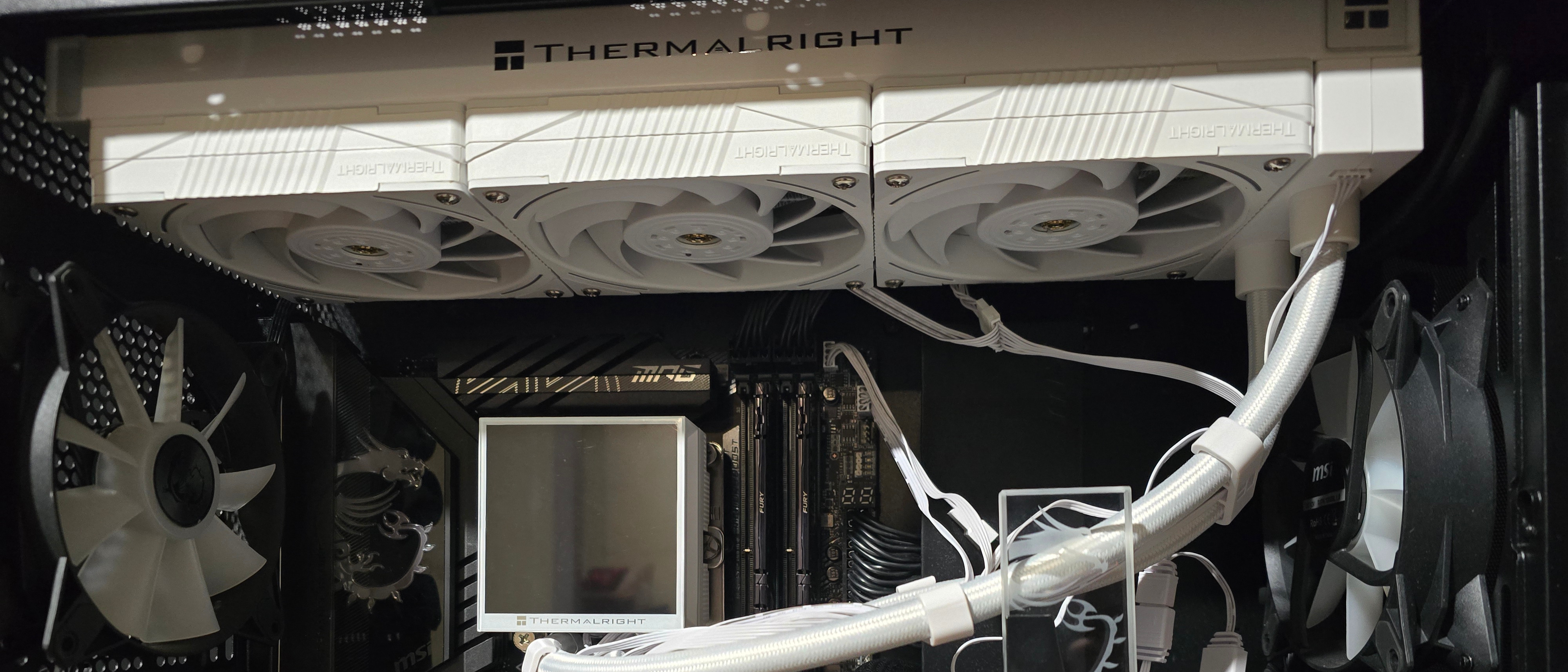Why you can trust Tom's Hardware
CPU-only thermal results without power limits
Without power limits enforced on Intel’s Core Ultra 9 285K and i7-14700K CPUs, the CPU will hit its peak temperature (TJ Max) and thermally throttle with even the strongest of air coolers and even most liquid coolers on the market. For the best liquid coolers on the market, the results of this test will be shown using the CPU’s temperature. However, when the CPU reaches its peak temperature, I’ve measured the CPU package power to determine the maximum wattage cooled to best compare their performance. It’s important to note that thermal performance can scale differently depending on the CPU it’s being tested with.
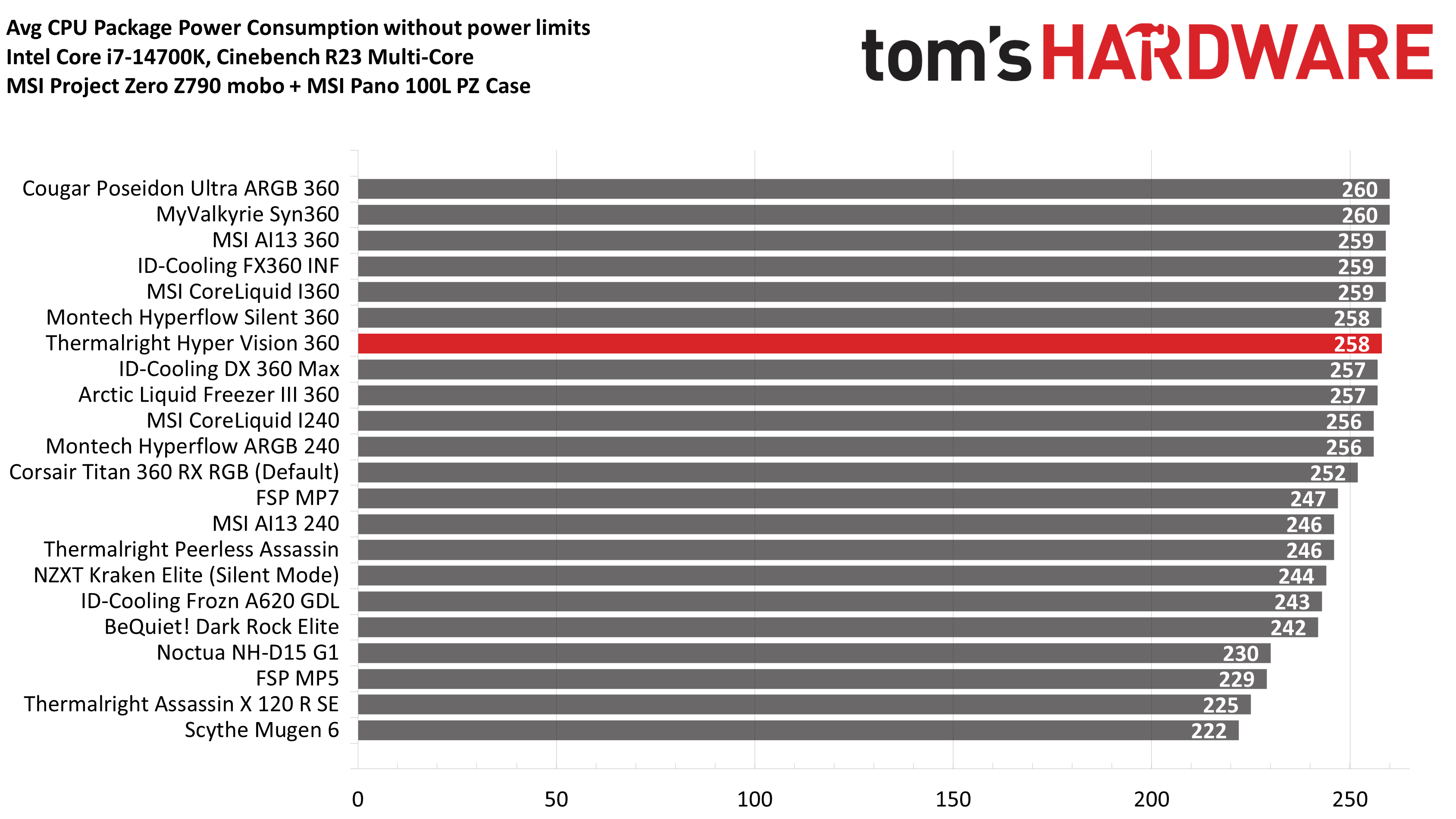
Looking at the results here with Intel’s “Raptor Lake” Core i7-14700K, you’ll notice the chart is measuring the CPU package power instead of the average temperature. This is because while Thermalright’s Hyper Vision 360 is a strong AIO, it isn’t strong enough to keep the CPU from reaching its peak temperature in stress testing.
It is important to remember that CPU coolers can scale (and perform) differently depending on the CPU it is paired with due to differences in manufacturing processes and the location of hotspots on the CPU – and in this case, the Hyper Vision 360 performs even worse with Arrow Lake. In fact, in my stress testing, FSP’s MP7 air cooler actually performed better than Thermalright’s AIO on Intel’s Core Ultra 9 285K CPU.
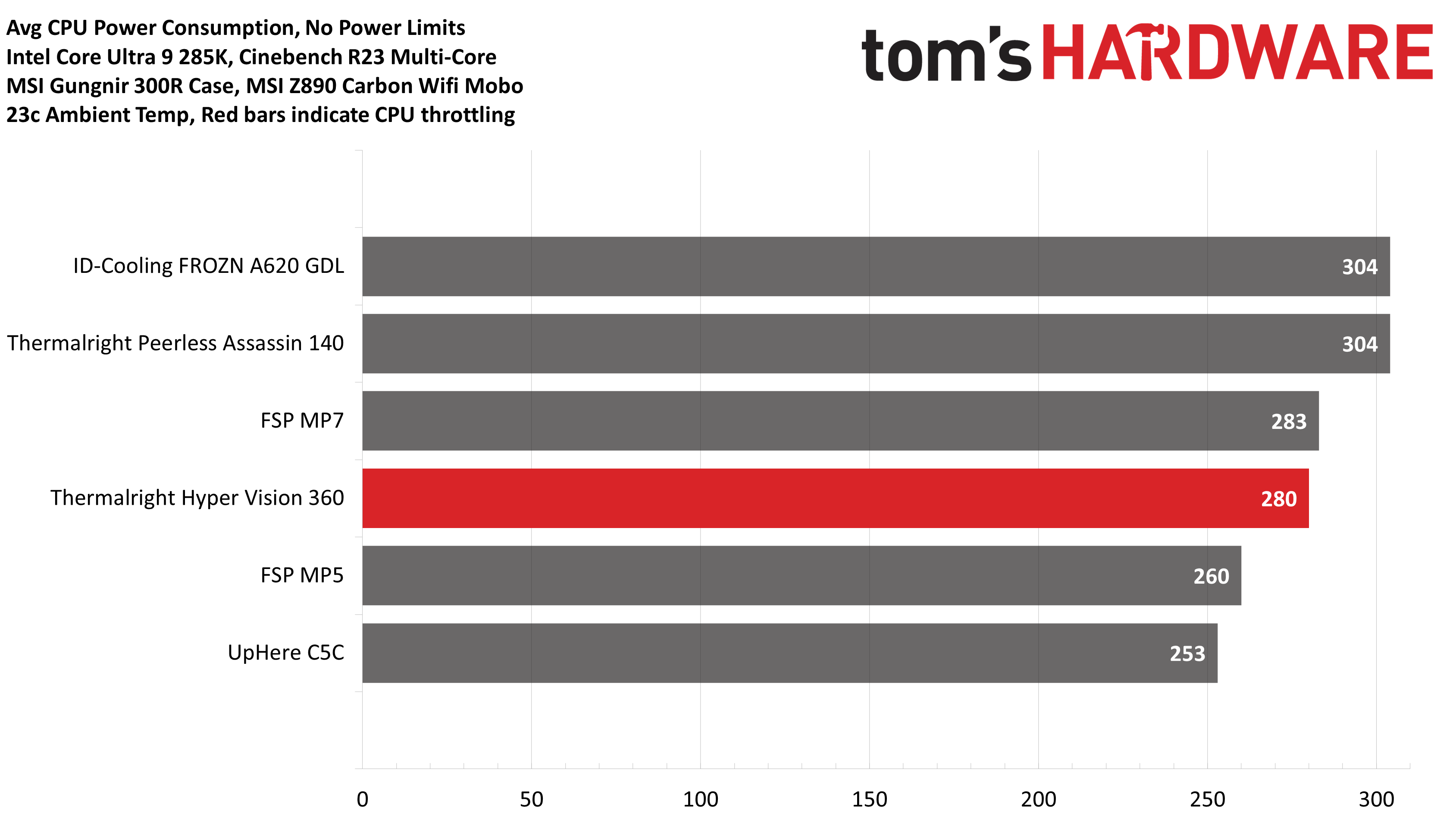
Worse yet, this cooler runs LOUD by default, reaching a whopping 53 dBA! I don’t understand why Thermalright let these fans run so loudly, especially since – as the next section will show – they perform well even when normalized to low noise levels!
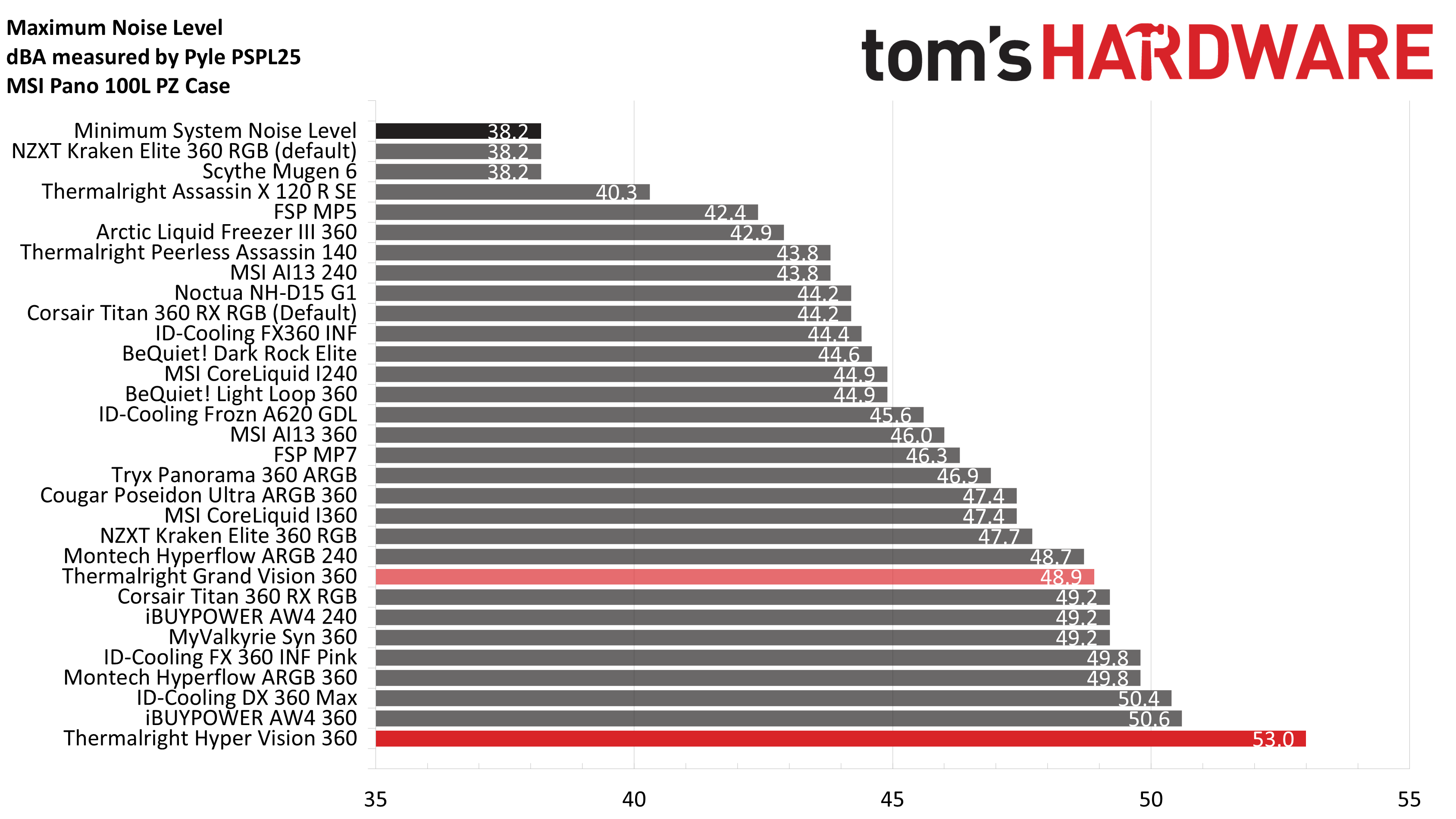
CPU-only thermal results with noise normalized to 38.9 dBA
Finding the right balance between fan noise levels and cooling performance is important. While running fans at full speed can improve cooling capacity to some extent, the benefits are limited and many users prefer a quieter system.

While this cooler’s default behavior is loud with underwhelming maximum performance, when noise-normalized, it is very strong, losing only 1W of performance – a figure so small as to only be relevant for benchmarking.
253W results
Get Tom's Hardware's best news and in-depth reviews, straight to your inbox.
My recent reviews have focused more on tests with both the CPU and GPU being stressed, but many of y’all have indicated that you would like to see more CPU-only tests. In response, I’ve started testing Intel’s “Arrow Lake” Core Ultra 9 285K with a 253W limit.
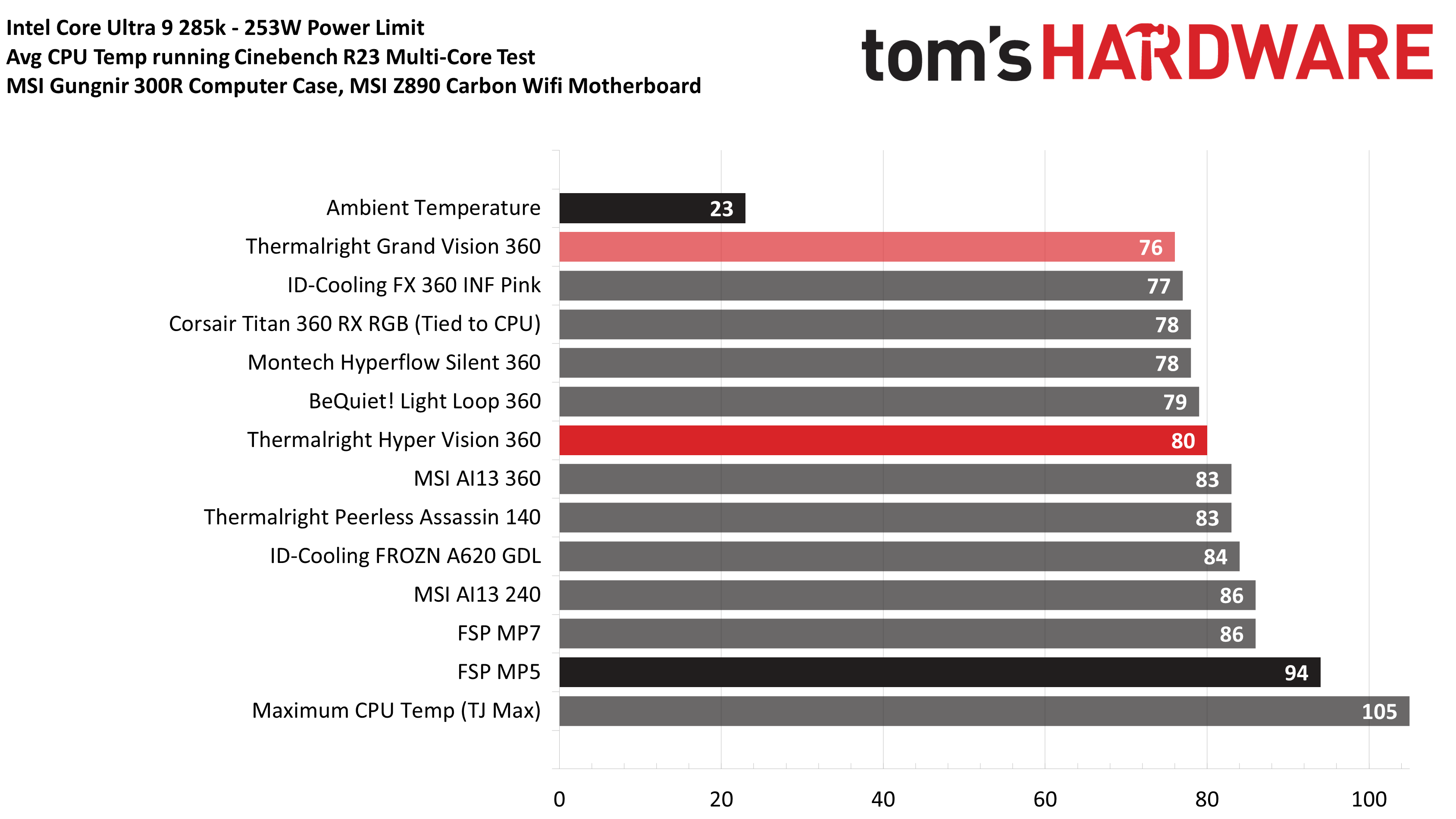
The results of Thermalright’s Hyper Vision when a more reasonable 253W limit is imposed on Intel’s Core Ultra 9 285k aren’t as good as I had expected. At 80 degrees C, it’s 3C ahead of the worst result I have from an AIO in this benchmark and 4C behind the best result I’ve recorded. My results are somewhat limited here, but I expect this to be more or less “average” for AIOs I test in the future.
135W CPU + 290W GPU results
Testing a CPU Cooler in isolation is great for synthetic benchmarks, but doesn’t tell the whole story of how it will perform. I’ve incorporated two tests with a power limit imposed on the CPU, while also running a full load on MSI’s GeForce RTX 4070 Ti SUPER 16G VENTUS 3X.
The CPU power limit of 135W was chosen based on the worst CPU power consumption I observed in gaming with Intel’s Core Ultra 9 285K, which was in Rise of the Tomb Raider.
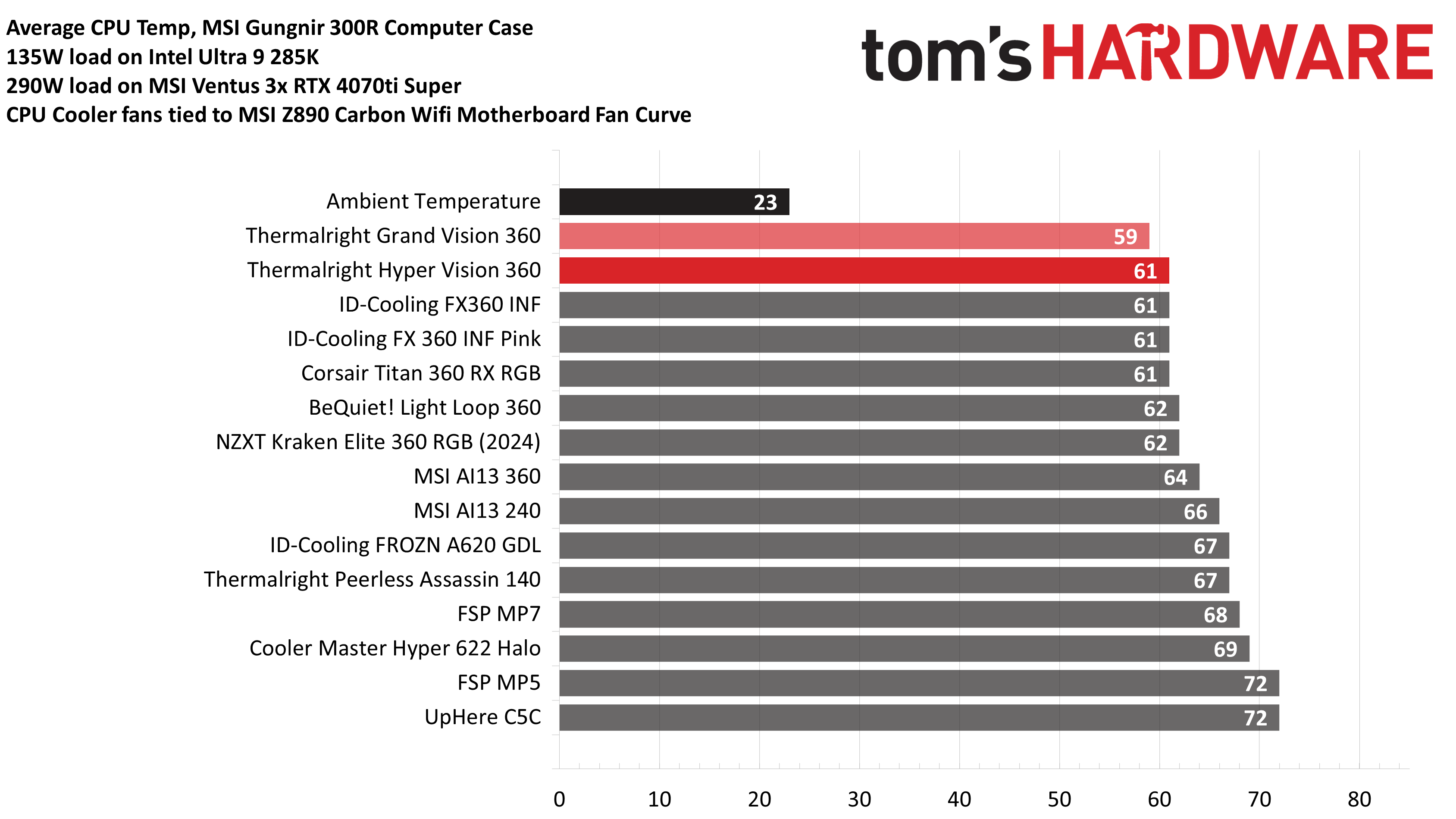
In this test, the Hyper Vision 360 actually performs very well – at least in terms of overall temperature. It averaged 61C, only 2C behind the best result we’ve recorded. In terms of noise levels (when tied to the default fan curve of my motherboard) it wasn’t too bad either, measuring at 41.4 dBA – though this is technically the third-loudest result in this chart.
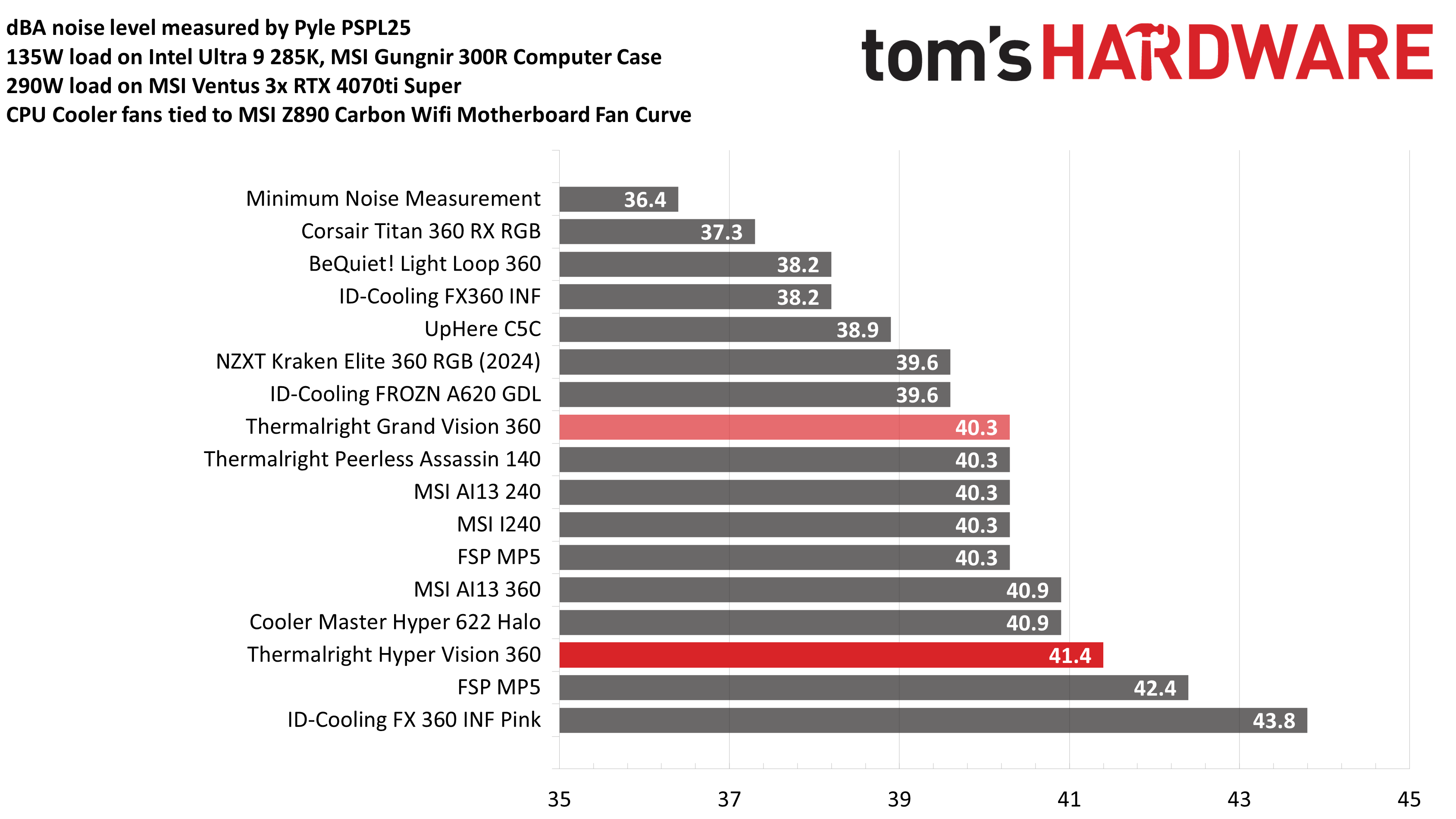
85W CPU + 290W GPU results
Our second round of CPU + GPU testing is also performed with Arrow Lake. The power limit of 85W was chosen based on typical power consumption in gaming scenarios using the Core Ultra 9 285K CPU. This should be fairly easy for most coolers, the main point of this test is to see how quietly (or loudly!) a cooler runs in low-intensity scenarios.
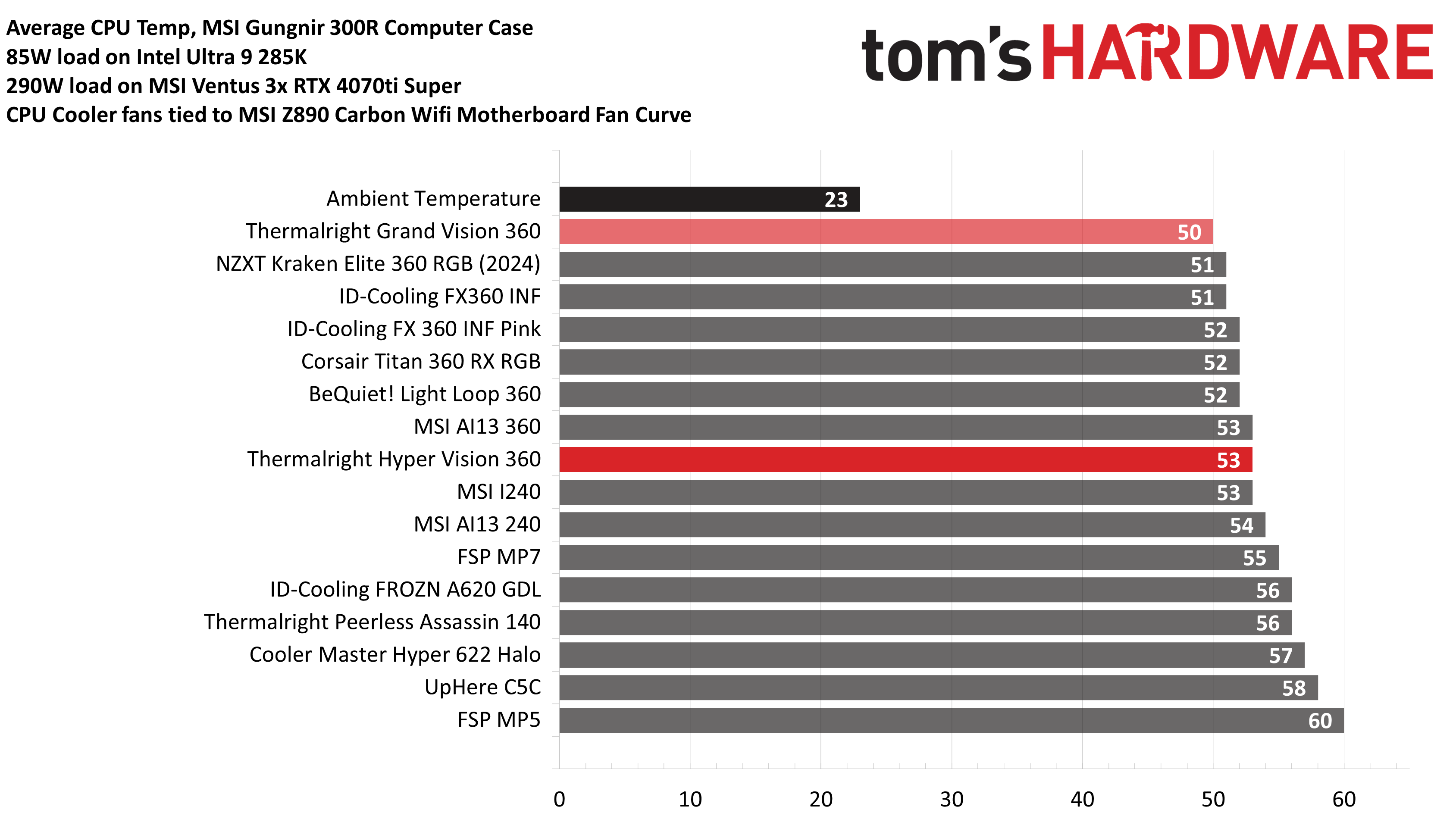
With a CPU temperature of 53 degrees C, the thermal performance was alright. What’s frustrating about the results in this section is the noise levels. Looking at the chart, you might think: But Albert, that reading of 38.9 is even better than the Grand Vision 360!
And that technically would be true. But what this chart is incapable of expressing is that in the case of the Hyper Vision 360, the noise level is caused by the pump whine of the unit I tested. If the pump wasn’t noisy, the rating here would be even quieter – and that annoys me because this cooler would be a better value if the pump was properly tuned! Pump whine has a more irritating pitch and frequency to its noise than any PC fan I’ve heard.
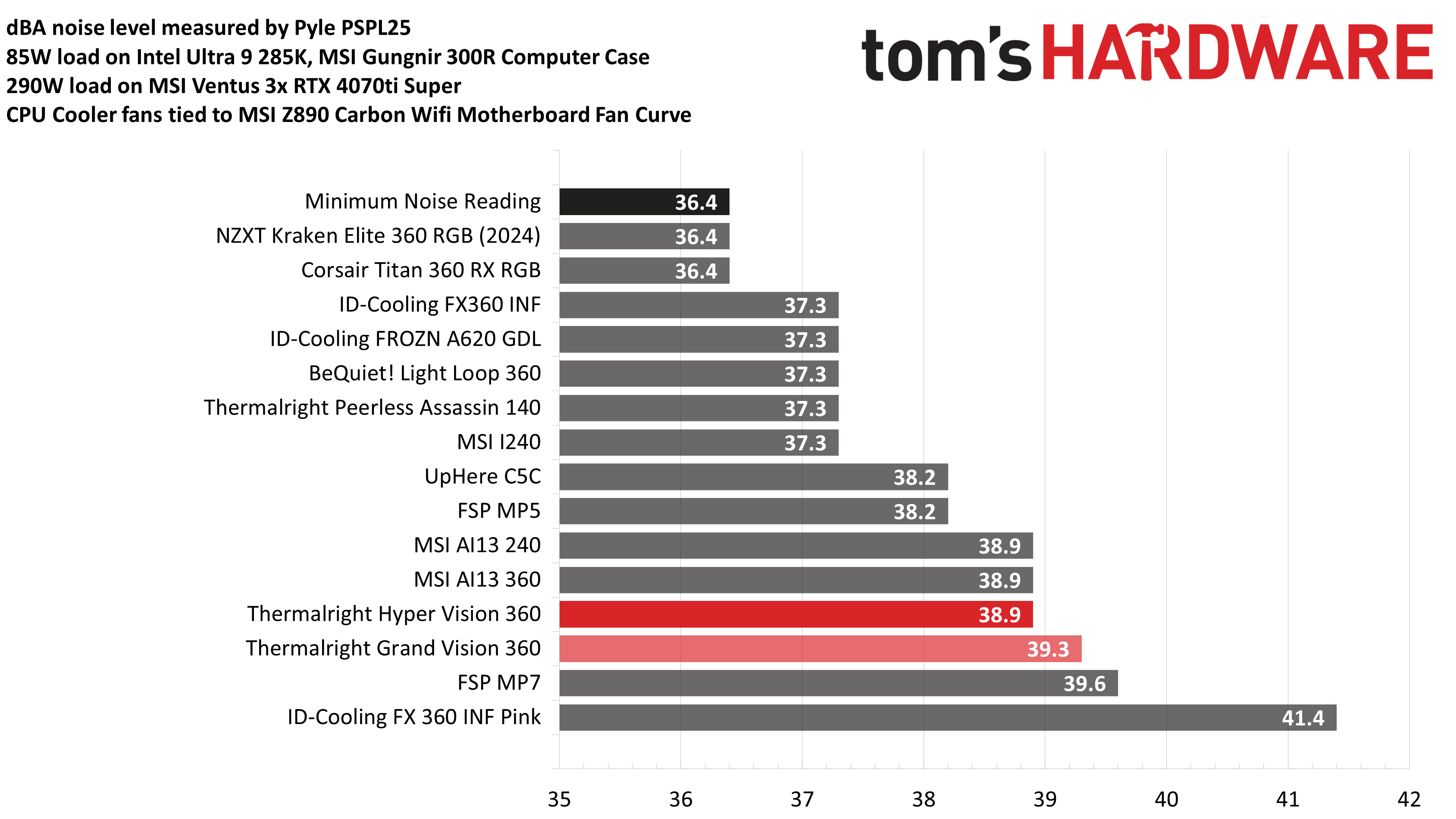
Conclusion

Unless you really need a slightly larger LCD screen, I advise passing on Thermalright’s Hyper Vision 360. Instead, most users should consider purchasing Thermalright’s superior Grand Vision 360 instead. Both AIOs cost the same, but the Hyper Vision 360 has worse overall performance and minor but noticeable pump whine. Most of the time, thanks to test results, I gladly recommend Thermalright products. But in this case, the Hyper Vision 360 is an example of unnecessary SKU spam that only serves to confuse customers. It’s not worth your time or hard-earned money.

Albert Thomas is a contributor for Tom’s Hardware, primarily covering CPU cooling reviews.
-
thestryker I wonder if this is an indicator of a QC situation because the pumps on the two appear to be the same one. When looking through varied SKUs on previous Thermalright models I noticed their naming would sometimes correlate to different pumps.Reply
At the end of the day I do agree the constant SKU spam is a problem and a much bigger one for AIOs than air coolers. If they're going to continue this I'd really like them to identify their pumps clearly so at the very least the buyer would know if there's any difference there. -
LabRat 891 I really wish somewhere like Tom's would buy 1ea of every one of their AIOs and do a "Can you go Thermalwrong?" comparison across the models. As-is, I have no idea what the diffs are between all of their AIOs on Amazon.Reply -
beyondlogic Replythestryker said:I wonder if this is an indicator of a QC situation because the pumps on the two appear to be the same one. When looking through varied SKUs on previous Thermalright models I noticed their naming would sometimes correlate to different pumps.
At the end of the day I do agree the constant SKU spam is a problem and a much bigger one for AIOs than air coolers. If they're going to continue this I'd really like them to identify their pumps clearly so at the very least the buyer would know if there's any difference there.
its called market flooding thermalright has done this with even air coolers lol. there can be 3 types of the same air cooler with slight alterations its like there trying to plug every market area. -
wakuwaku ReplyThermalright includes an accessible refill port hidden behind a sticker with its logo on it, and while they don’t include a scary sticker on top of the refill port, their warranty policy is no different than those that do. If you attempt to service your AIO by refilling it, Thermalright will deny you warranty service.
Citation please. Not doubting you or anything but if you want to change this you would first have to provide citations in order to make a proper complaint with legal basis. I am very sure human hallucinations are just as useless as AI hallucinations in court.
You do know that deepcool is banned in the US. There is no point in US based reviewers and websites to review a product that they can't obtain legally and a consumer cannot buy legally.lebaoan said:i hope you will review Deepcool Mystique 360 and compare it with Hyper Vision 360 -
thestryker Reply
I know what they're doing, but the problem is when there are fundamental differences like pump type. There's a Core, Elite, Grand, Mjolnir and Hyper model of Vision and they do not all appear to have the same pump. This isn't like the Assassin coolers where you can just look at the number of towers and heatpipes to know what you're buying.beyondlogic said:its called market flooding thermalright has done this with even air coolers lol. there can be 3 types of the same air cooler with slight alterations its like there trying to plug every market area. -
YSCCC Reply
that could be, and AFAIK their product line jewel is usually at the dirt cheap too good to be true with minimal gimmick segment, like the PA120, and I am using their Frozen Edge 360 which can tame the undervolted 14900K with OCCT AVX2 extreme 30min under 90C in 25C room ... at all P core 5.9Ghz E cores 4.5Ghz using 320W power cap..thestryker said:I wonder if this is an indicator of a QC situation because the pumps on the two appear to be the same one. When looking through varied SKUs on previous Thermalright models I noticed their naming would sometimes correlate to different pumps.
At the end of the day I do agree the constant SKU spam is a problem and a much bigger one for AIOs than air coolers. If they're going to continue this I'd really like them to identify their pumps clearly so at the very least the buyer would know if there's any difference there. -
Albert.Thomas Reply
That's an interesting idea!LabRat 891 said:I really wish somewhere like Tom's would buy 1ea of every one of their AIOs and do a "Can you go Thermalwrong?" comparison across the models. As-is, I have no idea what the diffs are between all of their AIOs on Amazon. -
Albert.Thomas Reply
1) I'm a reviewer, not a lawyer. I'm not making any legal complaints ;)wakuwaku said:Citation please. Not doubting you or anything but if you want to change this you would first have to provide citations in order to make a proper complaint with legal basis. I am very sure human hallucinations are just as useless as AI hallucinations in court.
2) I asked my contact with Thermalright directly. I'm not sure if it would be appropriate to screenshot the email, so I'm gonna pull a Linus and say "Just trust me, bro". Or you can ask Thermalright yourself, I asked them because they told the same thing to illusional -
metaldrakon Hi everyone, I just bought a 9950X3D and I'm currently waiting for all the parts to arrive so I can build the PC.I've been researching the best AIO cooler I could use to keep the CPU temps under control. Like many of us, I've been a bit confused by the different models Thermalright offers. But I saw that the Hyper Vision 360 has a UB model, specifically the Hyper Vision 360 UB ARGB.Reply
According to the info on their website, both the GrandVision and the HyperVision use a pump rated at 6400 RPM, but they have different airflow specs:
GrandVision 360: 80.45 CFM (MAX)
HyperVision 360: 69 CFM (MAX) (Lower airflow, which means potentially lower performance)
HyperVision 360 UB: 207 CFM (integrated - MAX)
When comparing the HyperVision 360 UB to the Arctic Liquid Freezer III 360, it seems like it might have better cooling performance. Based on the review I saw here at toms hardware of both Thermalright models, and considering the CFM differences, I would think the UB model is the best option.
What do you all think? Does my assumption sound right?
Thanks in advance!
